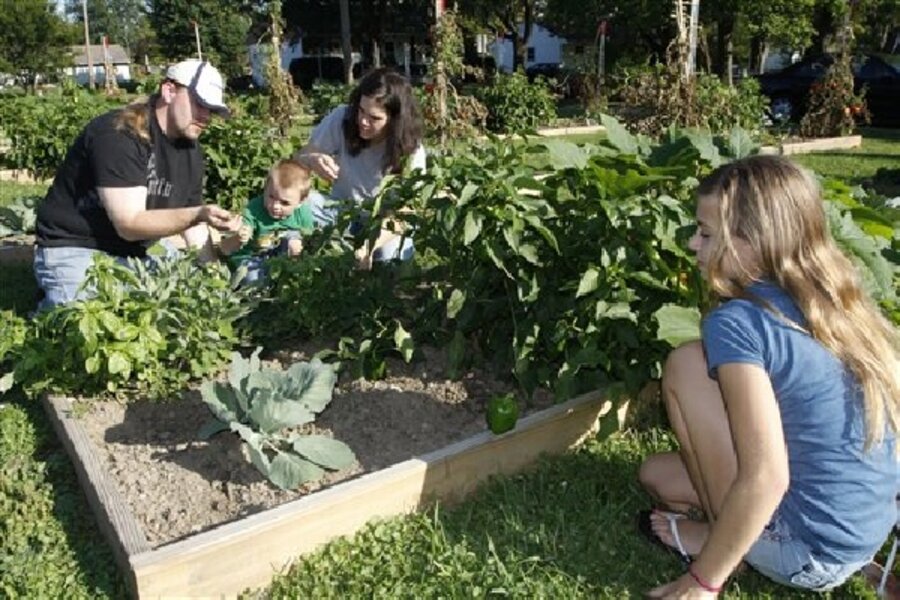Unemployed workers learn to grow their own food
Loading...
| WILMINGTON, OHIO
Many of the new gardeners didn't know how to grow vegetables, and weren't sure what to do with them once they did.
They learned, though, as part of a project by a local college to help a community hard-hit by the recession grow some of its own food.
Wilmington College provided the 20 plots and the guidance in this southwestern Ohio town after DHL Express decided last year to close its operation here, putting most of 8,000 Wilmington Air Park employees out of work. Local unemployment has soared to 15 percent.
Food pantries and other charities reported unprecedented demand, so the school, besides using its agricultural program to raise and donate crops, decided it could have a lasting impact by teaching people to garden.
"It's not about a handout, it's a hand up," says Chris Burns-Dibiasio, whose husband, Daniel, is president of the private college of some 1,700 students. "It's teaching them how to supplement their groceries; it's about building a local food system."
The "Grow Food, Grow Hope" program began in late spring in a grassy lot next to a college parking lot. The 20 initial families were identified with the help of social services agencies.
Students and staff set up 4-by-12-foot plots, and provided manure and compost. An anonymous donor helped cover costs, from hoes for each family to a solar-powered electric fence to keep out critters.
Now, nine volunteers from VISTA, the national service program, are also helping out, trying to expand the program to more families and more seasons, and teach schoolchildren how to garden.
"We were surprised; we didn't know that this little area could produce so much," says Mandy Gillis as her 4-year-old son, Logan, plucked ripe tomatoes off the vines the family planted and grew themselves.
She and her husband, Josh, have enjoyed watching their four children eat broccoli straight from the garden, and have become experts on all things zucchini: zucchini bread, zucchini muffins, zucchini cakes, zucchini spaghetti sauce, hamburgers mixed with zucchini.
Every Tuesday evening, the families came to plant, weed and finally harvest, with the help of Wilmington teachers and volunteer "master gardeners" from the community.
"I would tell them, 'If it doesn't look like what you planted, it's a weed, pull it up!'" recounts Monte Anderson, an agriculture professor who helped direct the project.
Community gardens are on a roll across the country, from the one Michelle Obama began on the White House lawn to "urban gardens" in cities from New York to San Francisco. They are popular for aesthetic, environmental, nutritional and economic reasons.
"There was a lot of motivation here," Mr. Anderson says.
Gardeners need to remain committed, he says, or community gardens can turn into a mess. Two families dropped out in Wilmington but were quickly replaced. The project's structured approach, including weekly meetings, helped keep it on target, Anderson says.
As the first lettuce, green beans and tomatoes ripened, gardening lessons were supplemented by demonstrations on cooking and preserving crops. The lessons were conducted using a picnic table and a portable stove.
"It was pretty primitive out here," says Anderson with a laugh, adding that the school is seeking grants for more cooking equipment and other materials for next year.
Lori Fetherolf, who had been without a steady job for nearly a year, says she had always considered a garden too demanding, but was pleasantly surprised that by regularly investing about an hour a week — more during harvest time — she could grow many vegetables to get her through the winter.
"It's been a tremendous help," she says. "Vegetables are expensive in the grocery store."
She learned to make fresh radish dip and to cook squash for the first time. She grew nearly 100 tomatoes. She says she realized that while unemployed, she had been filling up on cheap foods that weren't good for her.
"This has allowed me to start eating healthier," she says. "I'm amazed at how much better fresh green beans taste than out of the can."
With their newly acquired agricultural knowledge, the Gillis family is planning a garden at home next year and possibly a second garden for corn, which takes up too much ground for the small college plots.
"We learned a lot of basic things," says Josh. "We learned how far down to plant the seeds, how far apart to spread them. I didn't know; I thought you just put it in the ground and it all comes up."
But they also want to participate again in the college project.
"I've met a lot of people here. We share vegetables with each other," he says. "It's really been good to get out here in the community and work together."
Editor’s note: For more on gardening, see the Monitor’s main gardening page, which offers articles on many gardening topics. Also, check out our blog archive and our RSS feed. You may want to visit Gardening With the Monitor on Flickr. Take part in the discussions and get answers to your gardening questions. If you join the group (it’s free), you can upload your garden photos and enter our contests.






